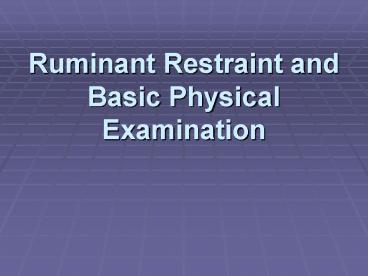Ruminant Restraint and Basic Physical Examination - PowerPoint PPT Presentation
1 / 24
Title:
Ruminant Restraint and Basic Physical Examination
Description:
Ruminant Restraint and Basic Physical ... Dairy Cattle Dairy cattle are handled more frequently and spend much ... Breeding is done by artificial insemination. – PowerPoint PPT presentation
Number of Views:78
Avg rating:3.0/5.0
Title: Ruminant Restraint and Basic Physical Examination
1
Ruminant Restraint and Basic Physical Examination
2
Question
- Livestock husbandry practices are dictated by the
intended use of the animal. - Even though all cattle have similar instincts,
husbandry practices can have a significant effect
on an animals behavior. - What are some of the basic behavioral differences
of beef cattle and dairy cattle that affect the
way that they are handled and restrained?
3
Beef Cattle
- Prior to entering the feedlot, beef cattle spend
most of their time in open range or field
settings. - Handled and restrained only occasionally
vaccination and deworming. - Suspicious of humans and enclosures, and are
usually more difficult to segregate and restrain.
4
Dairy Cattle
- Dairy cattle are handled more frequently and
spend much less time in open settings. - Dairy cows are milked twice daily while
lactating, and the lactation cycle lasts on
average 8-10 months of the year. - Breeding is done by artificial insemination.
- Calves are often reared in enclosures with
frequent human contact. - In generaL, dairy cattle tend to be much easier
to handle and restrain. (Caution on dairy bulls)
5
Most veterinarian procedures required two stages
of animal handling
- The individual most be separate from the herd.
- The individual must then be restrained
appropriately for the procedure
6
- The working chute is designed to hold one animal
at the time
7
(No Transcript)
8
Nose lead
9
(No Transcript)
10
- Head restraint may be applied to cooperative
animals, without use of a chute, but most
individuals must be placed in a chute first. - "the part that draws goes under the jaws."
11
- Cattle halters are used to control the head by
tying or securing the head to an immovable object
with a rope attached to the halter
QUICK RELEASE
12
- Nose leads are another method of head restrain.
They apply blunt, pinching pressure to the nasal
septum. - Nose tongs are not to be used as the only head
restraint - Nasal septum may be torn with violent movement
13
Nose rings
- Placed through the nasal septum and are often
used in bulls - Should not be used to tie the head for head
restraint, it is only for additional control of
the head but, as with nose leads, the nasal
septum can be torn
14
(No Transcript)
15
Tail Restraint
16
Hobbels/ Hoppels No Kicking
Over common calcaneal tendon Just above the hocks
17
Flank rope No Kicking
18
Front Leg Hoppel
ASSISTANT
19
Beam and Hook - HL
Other method
20
Casting Rope Squeeze
- Casting is a method of forcing an animal to the
ground, usually with ropes - Prefer R lateral recumbency discourages bloat
21
Casting Burley Method
22
Calf restraint
- Separate the calf from mother first.
23
Calf restraint
- Do not throw the calf to the ground
- Do not place the entire bodyweight on the calf
and do not occlude the trachea
24
Video
- http//vetvideos.com/restraintcattle.htm
- http//video.google.com/videoplay?docid-172502694
2547112254 - http//video.google.com/videoplay?docid8512037042
653473796 - http//video.google.com/videoplay?docid-676121704
8822203559 - http//video.google.com/videoplay?docid-335665491
3389880021































